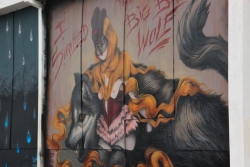Much of the area’s unique structures create a perfect surface to allow for artistic expression. So just how street did art originated from the crude images that conjure upon thinking of the term, graffiti?
Seductive and yet uncompromising and due to its close associations with gang culture, street art is sometimes thought of in pejorative terms.
Street art can be found in the corners and around edges of nicely painted buildings, on post beams and throughout alleyways in Culver City surrounding areas. In the 1990s, the city launched a revitalization program where it renovated its downtown area as well as shopping center areas along Sepulveda Boulevard.
The Culver City Arts District is in the eastern part of the city where there is an influx of diverse cultures, many art galleries and restaurants. The New York Times has praised this small creative area and called Culver City a “nascent Chelsea,” after the popular high end New York artistic enclave. International recognition has only served to increase the popularity and support of street art, encouraging and inspiring an entirely new wave of artists.
The word graffiti actually derives from the Italian word “graffito,” which translates as “scratch.” During the Prehistoric Era, man would essentially “scratch” images onto cave walls and during the Roman Empire, warriors would “scratch” images on the walls of the buildings in their conquered cities.
During World War II, both the Nazis and anti-Nazi groups used graffiti as a popular propaganda medium. Many speculate that it was in fact, during World War II that the use of graffiti began its radical shift to a lower art form.
Graffiti has been used as vandalism, writing derogatory names and slander in public areas, called “tagging.” Gang culture thrived and gang members began marking public property with their names, tags and titles. Soon after, the art form improved, and graffiti moved out of the insular gang culture and into popular culture.
Young artists found relief in the new medium as it offered a relevant and creative new way to express themselves, but street art had yet to become a part of an academic institution because there were no rules or boundaries.
These artists had poetic rights and absolute freedom to create their own unique style and form. Probably one of the most well-known artist is “Banksy,” who has gone on to not only achieve wide acclaim for his street art, but for his paintings, books and films as well. Banksy infuses his work with social and political commentary, often employing a satirical wit and dark humor to make his point.
His work has been seen in Australia, the United States, France, Spain and even Palestine.
The general public has become more tolerant and even more supportive of graffiti art, and there have even been exhibits and galleries dedicated to the form. The Museum of Contemporary Art in Los Angeles recently organized an exhibit celebrating street art on walls, subways and buses.
The exhibit attracted a great deal of attention and praise from the public, thus inspiring other institutions and organizations to act on the same accord. The prestigious “Born in the Streets” exhibit was held at the Foundation Center in Paris, celebrating street art in Europe.
The Culver City area is now considered a place for lovers of good food, good fun and great art.

